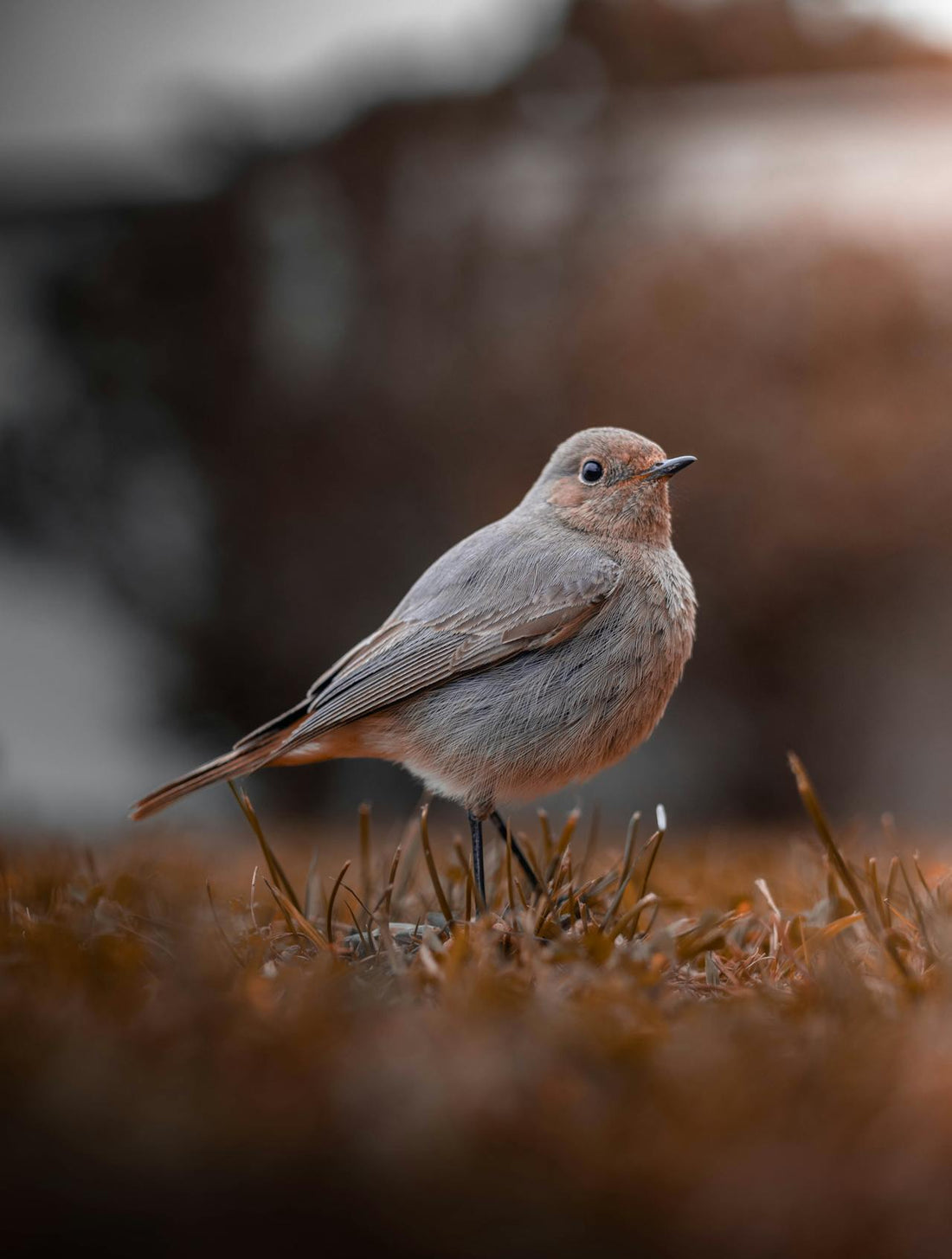
Bird of the Year 2025: A portrait of the black redstart
Every year, nature conservation organizations in Germany select a bird of the year to draw attention to a particular species and its habitats. In 2025, after a public vote with over 143,000 participants, the choice fell on the black redstart (Phoenicurus ochruros). This friendly songbird is known to many families as a frequent guest in settlements and is affectionately known as the "little redstart" because of its rust-colored tail feathers. But what makes the common redstart so special and why does it deserve our attention right now? In this comprehensive portrait, we learn about its habitat, song and behavior, how to tell the difference between males and females, the challenges it faces and how we can help it in our own gardens.
As Bird of the Year 2025, the black redstart is in the spotlight - a bird that is representative of near-natural gardens and species-rich settlements. Its unmistakable song can be heard even before the sun rises: it begins around 70 minutes before dawn and sounds loud, partly melodious and partly grating. With its bold "Courage for the gap" slogan, the little bird also draws attention to an important issue: our modernized buildings offer it fewer and fewer places to nest. So it's high time to take a closer look at this feathered neighbor!
1. habitat and occurrence

The black redstart is originally an inhabitant of stony mountain landscapes - which is why the birds used to be called "mountain redstarts". However, the nimble insect hunter has long since found a temporary home in the lowlands: since the 18th century, it has spread from the mountains to large parts of Europe and Germany. Today it can be found from spring to fall in almost all regions of Germany, especially in villages and towns. Our houses are like artificial rocks to it; as a typical cultural successor, the black redstart has conquered our settlements and feels very much at home in gardens, backyards and parks. It prefers open, structurally rich environments - it can often be seen sitting on walls, fences or roofs, from where it overlooks its territory.
As a building-breeder, the black redstart uses niches and crevices in buildings to raise its young. It builds its cup-shaped nest of stalks and moss in cracks in walls, under eaves or on beams and gutters. Even unusual places do not deter them: nests have been found in carports, sheds or even on rarely used equipment. This proximity to humans is typical - hardly any other wild bird nests so naturally on our houses. For families with gardens, this means that the black redstart is a neighbor on six legs (or wings) that, with a bit of luck, can be observed right next to the house.
The black redstart usually only spends the warmer months of the year with us. Migratory bird: In the fall, from around the end of September, the majority of Central European black redstarts head south to spend the winter in the Mediterranean and North Africa. As early as late winter (February/March), the first singers return from their winter quarters to liven up our gardens with their warbling again. It is interesting to note that in recent years an increasing number of black redstarts have also been overwintering in Germany - presumably encouraged by mild winters and climate change. As a result, you may even see a black redstart flitting around the garden in December. Overall, however, the species is still considered a migratory bird that can be reliably found in our latitudes from March to October.
2. song and behavior

Early bird: The black redstart lives up to the saying "The early bird catches the worm". It is one of the very first singers at dawn and begins its song around 70 minutes before sunrise. His singing is unmistakable - although not beautiful in the classical sense, but rather rough and varied. Typical is a mixture of clanging and rasping tones, followed by melodic whistling sounds. Some compare the middle section of his performance to the sound of a squeaking garden pump. Nevertheless, this voice has its own charm: the "red-tail" announces its territory loudly and clearly. During the day, it often makes a sharp-sounding call that sounds like "fiiist" - an alarm call with which it warns conspecifics or enemies.
The black redstart also has interesting behavioral characteristics that even children quickly notice. For one thing, it constantly bobs or trembles with its eponymous tail - almost as if it can't keep still from excitement. This constant trembling of the reddish-brown tail feathers in combination with a slight "kink" (a bouncing up and down on its legs) is its trademark. Secondly, the black redstart is incredibly agile and nimble: It can often be seen flitting back and forth within its territory, from one vantage point to the next. It hunts insects both on the ground and in the air - similar to a flycatcher, it grabs flying mosquitoes and butterflies with short flights in the air. On the ground, it hops forward with a jerk, stops, bobs its tail and then pounces on a spider or beetle. It is also a flying artist: When singing, the male climbs steeply into the air and sails back down again with vibrating wing beats, while belting out its resounding song. All of these behaviors - from early singing to tail bobbing - make the black redstart an exciting garden bird that is wonderful to observe with a little patience.
3. distinguishing features of males and females
At first glance, redstart males and females appear inconspicuous - both are around 13-15 cm tall (about the size of a sparrow) and relatively slender in build. But a closer look reveals clear differences in their plumage. The male wears a smart dark "evening dress": Older males are predominantly sooty black to dark gray in color and have a distinctive snow-white wing patch on the wing. This white wing patch looks like a small badge and is a reliable distinguishing feature for male redstarts. Occasionally, males also have a light forehead spot and their breast is a deep dark grey color. In contrast, the male's tail is a particularly bright rusty red - which is why it is also known as a "black redstart". The following picture shows a male:

The female redstart is much more plainly colored. Its plumage appears uniformly gray-brown to gray-beige, without conspicuous markings. It lacks both the black contrasts and the white wing patch of the male. Only the tail is also red-orange in the female - the common feature of both sexes. However, as the female lacks the conspicuous white wing patch and the deep black, it appears much less conspicuous overall. Incidentally, young birds in their first year are similar to females: young males are also gray-brown at first and only acquire their dark "male plumage" with the next moult. The following picture shows a female black redstart:

In everyday life, it is relatively easy to tell the sexes apart as soon as you know what to look out for. A black-grey bird with an orange-red tail and a light wing patch - that's Mr. Redstart. A brownish-grey bird with an orange-red tail but no white spots - that's Mrs. Redstart. It's a great game for children to look for these differences in the garden or park. Once you have seen them both, you realize that they may belong to the same species, but they almost look like two different birds! Incidentally, the black redstart is sometimes confused with its relative, the common redstart. But don't worry - the male common redstart is much more colorful (with an orange breast and light forehead) and altogether much rarer in our gardens. The common redstart remains the more common "redstart" around the house and yard.
4. conservation status & challenges
The black redstart is not endangered - which is precisely why it is a symbol of the fact that we must not lose sight of common species. Nevertheless, it is facing two main problems: a lack of breeding sites on modern, "sealed" houses and the decline in insects due to pesticides and sterile gardens. As a building breeder, it needs niches, cracks and crevices - its motto "Courage to leave gaps!" calls for leaving space for nature. The decline in insects is also hitting them hard: without beetles, caterpillars and the like, they can't find food for themselves and their young.
There are also other risks such as domestic cats, extreme weather and climate change, which can throw breeding seasons and food supplies out of balance. The black redstart shows that even robust species need our attention - before it's too late.
5. how you can help the black redstart in your garden

Whether balcony, garden or house facade - a lot can be done with simple means:
-
Hang up nesting boxes: Redstarts prefer so-called half-caves - nesting boxes with a wide opening to the front. They are ideally placed at a height of around 2-3 meters, protected from the weather under the roof or on a quiet house wall. If you want to do it yourself, you can find here at the German Nature and Biodiversity Conservation Union (NABU) for easy-to-understand instructions on how to build a suitable half-hollow nesting box in German.
Or you can combine practical bird protection with exciting nature observation: our nesting box with camera also offers the black redstart an ideal home - and fascinating insights into breeding activity directly on your screen. - Encourage insects: Native plants, wild flowers, dead wood and no pesticides - this creates a living garden.
- Create structurally rich corners: Piles of stones, open patches of ground or old walls help with foraging and observation.
- Maintain breeding sites around the house: Include or maintain nesting opportunities during renovations - such as nesting stones or open garden huts.
- Observe & marvel: With binoculars and patience, the black redstart will become a star in your own garden - a great experience, especially for children.
Review & outlook
After the lapwing (2024) and the whinchat (2023), in 2025 the black redstart will draw attention to near-natural gardens and the protection of familiar species. Let's help it so that its cheerful song can still fill our gardens tomorrow. If you want to know which birds have been chosen so far - click here for the List of all annual birds. And if you're already curious about 2026: our favorites and predictions are already available!
Now it's your turn: Which bird do you think deserves the title? Share your favorites in the comments - we're excited!
